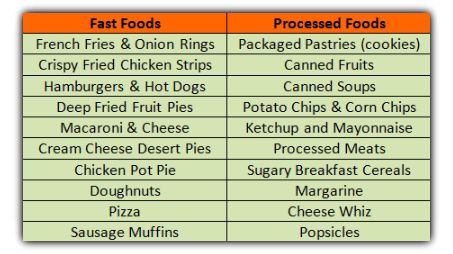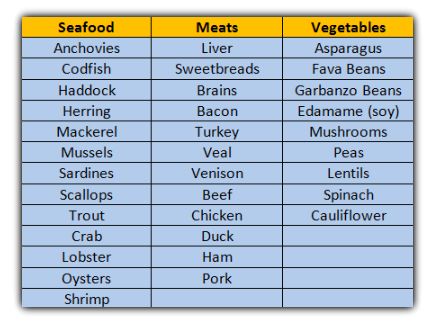It seems that foods to avoid with gout are the hottest of all topics related to gout. I have a lot to say about it, but I want to warn you… that you might not like what I have to say. Foods to avoid with gout are usually the same old rehashed list you’ve been hearing about for the last 300 years… and I’m sick of it.
The reason you’re getting one miserable gout attack after another is likely NOT because you can’t stay away from the froi gras and the port…as every other website about gout diets would like you to believe.
Diet plays a major role in the prevention and treatment of gout. Keeping a list of the foods you should and shouldn’t eat is essential to keeping your joints pain-free.
Gout is indeed extremely painful. Luckily, there is hope. By making some dietary adjustments, you can significantly reduce the risk of experiencing this horribly painful condition. It all starts with avoiding these foods.
Foods to Avoid With Gout
The foods you really need to avoid when it comes to the war on gout are fast foods and processed foods. This is for a number of reasons, these are the most obvious:
- they’re loaded with adulterated sugars
- they are criminally infused with rancid, damaged fats and transfats
- and they’re more of a synthetic chemical science project than food
Before we go any further, let’s lay to rest one of the biggest misconceptions and scams of our modern times; “all fats are bad for you”. This is BS and you can take it from Dr. Mercola where he tells you in his post titled, “The Forbidden Food You Should Never Stop Eating”.
Our bodies are made of proteins, carbohydrates and yes, FATS. There are a number of very healthy fats and fatty acids our bodies need to stay strong, healthy, and gout-free.
Fast Foods and Processed Foods
Here’s the list of gout-causing fast foods from fast food restaurants and processed foods from the grocery store that you need to avoid for gout – carbonated sugary sodas should be at the top of the list but we’ll get to those and alcohol in a minute:

Continuing on, other foods to avoid with gout that go without saying are candy bars and candy of any type. Generally speaking, anything that comes in a box, bag, can, or a bottle is suspect and doesn’t fit into a good gout diet.
The toxic chemicals that go into producing, processing, and packaging are not recognized by the body as food – they are therefore considered foreign invaders that the body wages war on to expel. This causes massive toxicity and acidity, and it compromises the function of the kidneys and liver and is the underlying cause of gout.
Purine Rich Foods
It IS important to know which of these purine-rich foods to avoid with gout, BUT I can guarantee, if you went and bought these foods from high quality sources, ate them sparingly and infrequently, your health would FLOURISH! Here they are:

Meat And Seafood Are High In Purines
Meat and Seafood can be the cause of excessive uric acid and result in gout.
So as far as trying to keep up a good gout diet, steer clear from seafood and meat, especially during a flare-up. Meat and seafood are rich in purines and once it enters our body, it is then broken down into uric acid.
When your gout is at bay, you have a little more freedom in your food choices. But to be safe, it would be best to keep your seafood and meat intake to a minimum. While these meat and seafood, in general, are prohibited, salmon and scallops are okay for an occasional indulgence.
While gout strugglers are allowed to indulge on some types of seafood, there are other foods to avoid with gout and should be completely taken off the menu. Herring, anchovies and tuna are just some of the best examples.
Red Meat Is Not All Bad
When it comes to purine content, all meat is not created equal. Generally, white meat is better than red meat. But gout-sufferers are allowed to eat some types of red meat once in a while.
Rather than turkey or lamb, you are a bit better off if your occasional indulgence is pork or beef. Lamb chops are also a better choice than leg meat.
Turkey Can Be Higher In Purines Than Other Meat Sources
Turkey and goose contains a significantly high amount of purine as compared to other types of food. That being said, it would be best to avoid them. Gout-prone folks should also avoid eating these foods as much as possible.
Duck and chicken are the safest choice. However, you should refrain from eating leg meat and skin.
Drinks to Avoid With Gout
Alcohol
Personally, I really don’t understand why this one gets so much attention. For all the same reasons that too much alcohol gives you a hangover, it’s obvious that it weakens your health and makes you prey for gout.
Of all types of alcohol however, beer is the worst. This might be a bit of a problem for some folks. Unfortunately, beer is a double-whammy for people with gout. Not only does it increase your uric acid level, it also makes it harder for the body to eliminate uric acid from your system.
To varying degrees, it contains purines. So if eating a bunch of purines is bad, go on a real bender and slam six or eight beers and see what that does for you.
While wine is a better option, heavy drinking is discouraged. During a flare, I would recommend that you stay away from alcoholic beverages entirely.
Sugary Drinks
Studies have now shown that one of the most potent ways to raise uric acid levels in the bloodstream is by consuming large quantities of fructose – as in High Fructose Corn Syrup. The biggest offender is carbonated soft drinks like Coca-Cola, Pepsi, Mountain Dew and others.
However the real danger comes from being misled by seemingly healthy fruit drinks and sports drinks. Additionally, HFCS is found in canned soups, baked goods, condiments, and canned and frozen fruits and much more.
What Are the Best Foods for Gout?
This is a list of common foods that can be included in a diet for gout sufferers:
- Meats: Meats are relatively straight-forward. Excellent choices are lean chicken/free-range chicken, grass-fed cuts of beef like filet mignon, and wild-caught salmon. The important thing when eating meat is to eat smaller portions (4 to 6oz), and only a few times per week.
- Vegetables: avocado, celery, bell pepper, cucumber, carrots, spinach, kale, and broccoli are excellent vegetable choices.
- Fruits: blueberries, apples, lemons, oranges, peaches, pears, bananas, red grapes.
- Nuts and Seeds
- Whole grains
- Vitamin C, Cherries, and Healthy fats
☆ Bottom-line: The foods to avoid with gout are really all the “edible food-like substances” found in every fast food restaurant and packaged up in every grocery store.
Most meats are high purine foods and you should be careful with them – but don’t completely discount them because there are a lot of important nutrients that we can get from no other sources.

“I know your pain. Let me help you kill your gout for good! And teach you to advocate for yourself and take ownership of your gout recovery, by showing you how to live the gout-free lifestyle.” Two decades ago, Bert Middleton found himself diagnosed with gout. Like 8.3 million other people in the United States (approximately 4% of the population), he struggled helplessly with the physical, emotional, social, and financial impact that gout left unchecked can have on your life. Prescription drugs were of limited help… And the terrible pain of regular gout attacks left him unable to enjoy even the simplest daily pleasures. His marriage was suffering. His finances were spiraling due to the impact gout had on his ability to work. And maintaining a social life was often nearly impossible. Tophi surgeries left him in terrible pain. And he found himself depressed … and angry … that gout was stealing years of his life.
Until one day, after hundreds of hours of research and self-experimentation, Bert finally had a breakthrough and created a blueprint for a way of living that would prove to be “the answer” to living gout-free for nearly a decade now. Today, Bert and his “Gout Wife” Sharon devote their evenings and weekends to educating other gout sufferers on how to live the gout-free lifestyle. Showing others his 911 Emergency Response Gout Recovery Plan for getting PAINFUL gout attacks under control in as little as 4 hours. And then, how to make daily choices that keep gout under control for GOOD! So you can finally start LIVING again!
